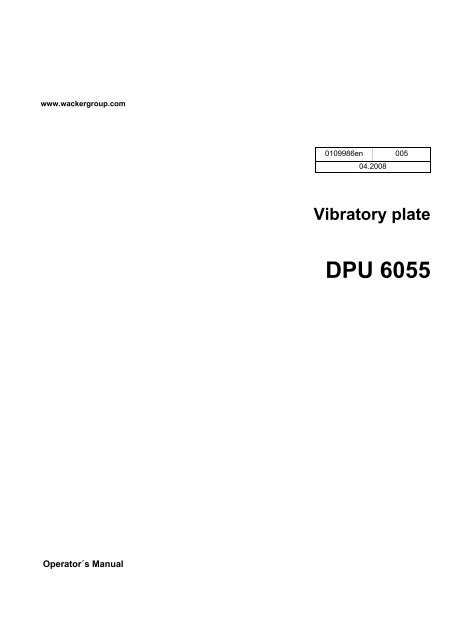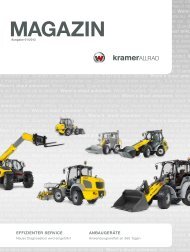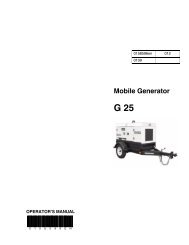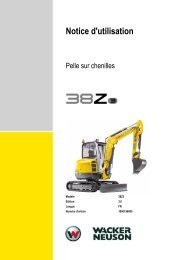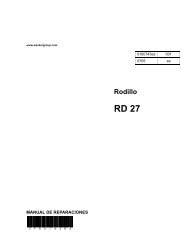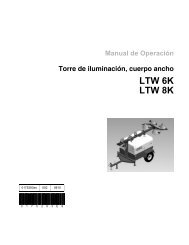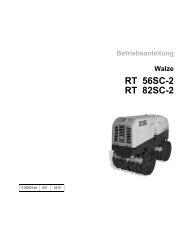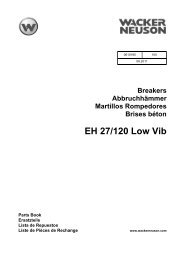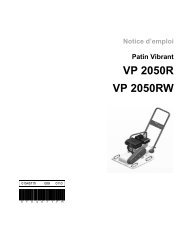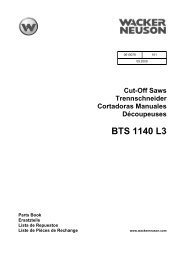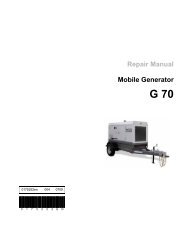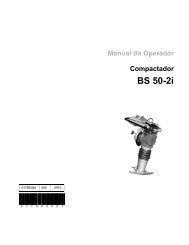DPU 6055 - Wacker Neuson
DPU 6055 - Wacker Neuson
DPU 6055 - Wacker Neuson
You also want an ePaper? Increase the reach of your titles
YUMPU automatically turns print PDFs into web optimized ePapers that Google loves.
www.wackergroup.com<br />
Operator´s Manual<br />
0109986en 005<br />
04.2008<br />
Vibratory plate<br />
<strong>DPU</strong> <strong>6055</strong>
Important information<br />
This machine has been provided with an EPA-certified engine.<br />
Additional information can be found in the engine<br />
manufacturer‘s notes.<br />
Engine exhaust, some of its constitvents, and certain vehicle<br />
components contain or emit chemicals known to the State of<br />
California to cause cancer and birth defects or other reproductive<br />
harm.<br />
T00940GB.fm 1<br />
WARNING<br />
Caution<br />
This engine is an EPA engine.<br />
Adjusting the engine speed will interfere with EPA certification and<br />
the emissions.<br />
Only authorized personnel can make adjustments to this engine.<br />
Please contact you nearest engine dealer or your <strong>Wacker</strong> Dealer for more<br />
information.
T00940GB.fm 2
2. Foreword<br />
Vorwort.fm 7<br />
Foreword<br />
For your own safety and protection from bodily injuries, carefully read,<br />
understand and follow the safety instructions in this manual.<br />
Please operate and maintain your <strong>Wacker</strong> machine in accordance with<br />
the instructions in this manual. Your <strong>Wacker</strong> machine will reward your<br />
attention by giving trouble-free operation and a high degree of<br />
availability.<br />
Replace faulty or defective components Immediately.<br />
All rights, especially the right for copying and distribution are reserved<br />
Copyright 2008 by <strong>Wacker</strong> Construction Equipment AG<br />
No part of this publication may be reproduced in any form or by any<br />
means, electronic or mechanical, including photocopying, without<br />
express permission in writing from <strong>Wacker</strong> Construction Equipment AG.<br />
Any type or manner of reproduction, distribution or storage on data<br />
carriers or storage mediums not authorized by <strong>Wacker</strong> represents an<br />
infringement of valid copyrights and will be prosecuted. We expressly<br />
reserve the right to make technical modifications - even without due<br />
notice - which aim at improving our machines or increasing their safety<br />
standards.
Table Of Contents<br />
1. Foreword 3<br />
2. Safety instruction 6<br />
2.1 General instructions ..............................................................................6<br />
2.2 Operation ...............................................................................................6<br />
2.3 Safety checks ........................................................................................8<br />
2.4 Maintenance ..........................................................................................8<br />
2.5 Transport ...............................................................................................9<br />
2.6 Maintenance checks ..............................................................................9<br />
3. Technical Data 10<br />
4. Description 12<br />
4.1 Applications .........................................................................................12<br />
4.2 Max. admissible inclination ..................................................................12<br />
4.3 Description of function .........................................................................13<br />
5. Transport to work site /Recommendations on compaction 15<br />
5.1 Transport to work site ..........................................................................15<br />
5.2 Recommendations on compaction ......................................................17<br />
6. Operation 18<br />
6.1 Starting ................................................................................................18<br />
6.2 Mechanical oil pressure control ...........................................................19<br />
6.3 Electric start .........................................................................................21<br />
6.4 Starting the engine with the safety starting crank ................................23<br />
6.5 Starting in cold weather .......................................................................26<br />
6.6 Starting with external battery etc. ........................................................28<br />
6.7 Forward and reverse motion ...............................................................29<br />
6.8 Compaction without extension plates ..................................................29<br />
6.9 Stopping the engine ............................................................................30<br />
7. Maintenance 31<br />
7.1 Maintenance schedule ........................................................................31<br />
7.2 Engine oil and oil filter .........................................................................32<br />
7.3 Air filter ................................................................................................34<br />
7.4 Fuel system .........................................................................................36<br />
7.5 Battery .................................................................................................38<br />
7.6 Hydraulic control ..................................................................................39<br />
4
5<br />
Table Of Contents<br />
7.7 Exciter .................................................................................................40<br />
7.8 Exciter V-belt .......................................................................................42<br />
8. Faults 43<br />
8.1 Forward speed too low ........................................................................43<br />
8.2 Reverse speed too low ........................................................................43<br />
8.3 No reverse motion ...............................................................................43<br />
8.4 Loss of hydraulic oil .............................................................................43<br />
8.5 The charge control lamp will not extinguish ........................................44<br />
8.6 Engine does not start ..........................................................................44<br />
9. Electricwirning-Diagramm 45<br />
10. Lables 46<br />
EC - Conformity Certificate 47<br />
DIN EN ISO 9001 Certificate 49
Safety instruction<br />
2. Safety instruction<br />
for the use of vibratory plates with combustion engines<br />
2.1 General instructions<br />
2.1.1 Vibratory plates may only be operated by persons who<br />
∗ are at least 18 years of age<br />
∗ are physically and mentally fit for this job<br />
∗ have been instructed in guiding vibratory plates and proved their ability<br />
for the job to the employer<br />
∗ may be expected to carry out the job they are charged with carefully.<br />
The persons must be assigned the job of guiding vibratory plates by<br />
the employer.<br />
2.1.2 Vibratory plates may only be used for compaction jobs. Both the<br />
manufacturer’s operating instructions and these safety instructions<br />
have to be observed.<br />
2.1.3 The persons charged with the operation of vibratory plates have to be<br />
made familiar with the necessary safety measures relating to the<br />
machine. In case of extraordinary uses the employer shall give the<br />
necessary additional instructions.<br />
2.1.4 This machine generates noise that exceeds the country-specific<br />
permissible noise levels (individual rating level). It may therefore be<br />
necessary to wear ear protection<br />
2.2 Operation<br />
2.2.1 The engine is started by way of an electric starter.<br />
2.2.2 When starting the diesel engine with a starter crank make sure you<br />
have assumed a proper position with respect to the engine and that<br />
your hands are placed properly on the crank.<br />
Only use the original engine manufacturer’s safety starting crank.<br />
To avoid a possible return kick, turn safety starting crank through with<br />
full force until the engine starts running.<br />
SV00071GB.fm 6
SV00071GB.fm 7<br />
Safety instruction<br />
2.2.3 The function of operation levers or elements is not to be influenced or<br />
rendered ineffective.<br />
2.2.4 During operation the operator may not leave the control elements.<br />
2.2.5 The operator has to stop the engine of the vibratory plate before going<br />
on breaks. The machine has to be placed such that it cannot turn over.<br />
2.2.6 Stop engine before filling fuel tank. When refilling fuel tank, do not<br />
allow fuel to come into contact with the hot part of the engine or spill<br />
onto the ground.<br />
2.2.7 Do not smoke or handle open fire near this machine.<br />
2.2.8 The tank lid must fit tightly. Shut fuel cock if available when stopping<br />
the engine. For long distance transports of machines operated by fuel<br />
or fuel - mixtures, the fuel tank has to be drained completely.<br />
Leaky fuel tanks may cause explosions and must therefore be<br />
replaced immediatelly.<br />
2.2.9 Do not operate this machine in areas where explosions may occur.<br />
2.2.10 Make sure that sufficient fresh air is available when operating vibratory<br />
plates equipped with combustion engines in enclosed areas, tunnels,<br />
galleries and deep trenches.<br />
2.2.11 During operation keep your hands, feet and clothes away from the<br />
moving parts of the vibraton plate. Wear safety shoes, and eye<br />
protection glasses in case of trench operation where falling sand<br />
stones maybe ejected.<br />
2.2.12 When working near the edges of breaks, pits, slopes, trenches and<br />
platforms, vibratory plates are to be operated such that there is no<br />
danger of their turning over or dropping in.<br />
2.2.13 Make sure the soil or subsoil to be compacted has a high enough load<br />
carrying capacity.<br />
2.2.14 Use appropriate protective clothing while working or while carrying out<br />
maintenance work.<br />
2.2.15 When traveling backwards the operator has to guide the vibration plate<br />
laterally by its guide handle so that he will not be squeezed between<br />
the handle and a possible obstacle. Special care is required when work<br />
ing on uneven ground or when compacting coarse material. Make sure<br />
of a firm stand when operating the machine under such conditons.
Safety instruction<br />
2.2.16 Vibratory plates are to be guided such that hand injuries caused by<br />
solid objects are avoided.<br />
2.2.17 Vibratory plates have to be guided such that their stability is<br />
guaranteed.<br />
2.2.18 Machines with integrated transport trolley may not be parked or stored<br />
on the trolley. This device has only been designed to transport the<br />
machine.<br />
2.3 Safety checks<br />
2.3.1 Vibratory plates may only be operated with all safety devices installed.<br />
2.3.2 Before starting operation, the operator has to check that all control and<br />
safety devices function properly.<br />
2.3.3 If defects in the safety equipment or other defects are detected which<br />
impair the safe operation of the internal vibrator, the supervisor is to be<br />
notified without delay.<br />
2.3.4 The machine must to be switched off immediately in case of defects<br />
jeopardizing the operational safety of the equipment.<br />
2.3.5 Process materials and operating fuels must be stowed away in<br />
receptacles or containers marked according to the respective<br />
manufacturers specifications.<br />
2.4 Maintenance<br />
2.4.1 Only use original spare parts. Modifications to this machine including<br />
the adjustment of the maximum speed set by the manufacturer are<br />
subject to the express approval of WACKER. In case of<br />
nonobservance all liabilities shall be refused.<br />
2.4.2 All drive units have to be switched off before carrying out maintenance<br />
jobs. Deviations from this are only allowed if the maintenance or jobs<br />
require a running engine.<br />
2.4.3 When working on vibratory plates equipped with electric starter,<br />
disconnect battery before carrying out maintenance or repair jobs on<br />
the electric parts of the machine.<br />
SV00071GB.fm 8
SV00071GB.fm 9<br />
Safety instruction<br />
2.4.4 Remove pressure from hydraulic lines before working on them.<br />
Caution: take care when removing hydraulic lines, for the oil may be<br />
very hot (up. over 80 o C). Precautions are to be taken to prevent oil<br />
from splashing into the operator’s eyes.<br />
2.4.5 All safety devices must be reinstalled properly immediately after<br />
maintenance and repair jobs have been completed.<br />
2.4.6 Do not hose down the machine with water after each use to avoid<br />
possible malfunctions. Do not use high pressure washers nor chemical<br />
products.<br />
2.5 Transport<br />
2.5.1 During transport, loading and unloading of vibration plates by means<br />
of lifting devices, appropriate slinging means or hooks have to be used<br />
on the lifting points provided for this purpose on the vibratory plate.<br />
2.5.2 The load-carrying capacity of the loading ramps has to be sufficient<br />
and the ramps have to be secure such that they cannot turn over. Make<br />
sure that no one be endangered by machines turning over by slipping<br />
or by moving machine parts.<br />
2.5.3 When being transported on vehicles, precautions have to be taken that<br />
vibration plates do not slip or turn over.<br />
2.6 Maintenance checks<br />
2.6.1 According to the conditions and frequency of use, vibratory plates have<br />
to be checked for safe operation at least once a year by skilled<br />
technicians, such as those found at WACKER-service depots and<br />
have to be repaired if necessary.<br />
Please also observe the corresponding rules and regulations valid in your<br />
country.
Technical Data<br />
3. Technical Data<br />
TD00693GB.fm 10<br />
<strong>DPU</strong> <strong>6055</strong><br />
Item no. 0610053 0610049 0610175<br />
Length x width x height<br />
Operating weight<br />
mm:<br />
without extension plates (550 mm) kg:<br />
(610 mm) kg:<br />
(710 mm) kg:<br />
(860 mm) kg:<br />
1700 x 710 x<br />
1190<br />
454<br />
469<br />
476<br />
499<br />
1700 x 860 x<br />
1190<br />
1700 x 710 x<br />
1190<br />
Power transmission From drive engine directly to exciter unit via<br />
automatic centrifugal and V-belts<br />
Exciter<br />
Vibrations<br />
Centrifugal force<br />
min -1 (Hz):<br />
kN:<br />
ca. 4150 (69)<br />
Oil Fuchs Titan Unic 10W40 MC (SAE 10W40)<br />
Oil quantity l: 0,75<br />
Drive motor<br />
Piston displacement<br />
Rated power (*)<br />
at rpm<br />
Operating rpm’s<br />
No-load rpm’s<br />
cm 3 :<br />
kW:<br />
min -1 :<br />
min -1 :<br />
min -1 :<br />
60<br />
455<br />
470<br />
477<br />
500<br />
Air-colled single-cylinder 4 stroke diesel engine with<br />
electric starter<br />
667<br />
9,3<br />
2650<br />
2880<br />
2950<br />
Oil Fuchs Titan Unic 10W40 MC (SAE 10W40)<br />
Oil quantity l: 1,6
Fuel Diesel<br />
Fuel consumption<br />
Tank capacity<br />
Electrical system<br />
l/h:<br />
TD00693GB.fm 11<br />
l:<br />
Technical Data<br />
Battery Special <strong>Wacker</strong>-battery for vibro plates -<br />
12 V - 55 Ah<br />
Alternator Rotary current generator with electronic regulator and<br />
rectifier<br />
Charging rate max.<br />
Charging voltage<br />
Starter Starter motor<br />
D.C.<br />
Hydraulic control<br />
A:<br />
V:<br />
V:<br />
Oil Fuchs Renolin MR 520<br />
Oil quantity l: 0,4<br />
Special lubricating grase L PA : 97 dB(A)<br />
The weighted effec-tive<br />
acceleration value, determined<br />
according to EN ISO 5349<br />
m/s 2 :<br />
<strong>DPU</strong> <strong>6055</strong><br />
(*) In accordance with the installed useful outlet power according to Directive 2000/14/<br />
EG.<br />
1,9<br />
7,0<br />
26<br />
14<br />
12<br />
4,9
Description<br />
4. Description<br />
4.1 Applications<br />
The vibratory plate has been designed for the compaction of almost<br />
every type of soil, both in trenches as well as surface compaction. In<br />
addition, it is possible to vibrate paving stones an concrete blocks by<br />
using extension plates up to 86 cm (accessories).<br />
Extremely cohesive as well as frozen soils are not suitable for<br />
compaction. An authorised specialist must give permission for the<br />
ground in question to be compacted.<br />
4.2 Max. admissible inclination<br />
T01005GB.fm 12
4.3 Description of function<br />
T01005GB.fm 13<br />
Description<br />
4.3.1 The vibration required for compaction is produced by the exciter (13)<br />
which is firmly joined to the lower mass (5). This exciter (13) is<br />
designed as a central vibrator with aligned vibrations. Such a principle<br />
permits the direction of vibration to be changed by turning the eccentric<br />
weights (15). In this way an infinitely variable transition between<br />
vibration in forward motion , at standstill and in reverse motion is<br />
possible. This process is hydraulically controlled with the operating<br />
control handle (6) on the centre pole head (7).<br />
Forwards Standstill<br />
Reverse<br />
4.3.2 The drive engine (1) anchored to the upper mass (4) drives the exciter<br />
(13). The torque is transmitted by means of a friction connection<br />
through the centrifugal clutch (11) and the exciter V-belt (12).<br />
4.3.3 The centrifugal clutch (11) interrupts flow of power to the exciter (13)<br />
at low engine speed and thus permits perfect idling of the drive engine<br />
(1).
Description<br />
4.3.4 The automatic V-belt pulley (10) combined with the centrifugal clutch<br />
(11) ensures optimum tension of the exciter V-belt (12) during<br />
operation and relief of the tension of the exciter V-belt (12) when the<br />
machine is being relocated or transported.<br />
4.3.5 Moreover, the automatic V-belt pulley (10) automatically adapts to the<br />
V-belt flanks in line with the wear and thus makes the entire drive from<br />
the engine (1) to the exciter (13) maintenance-free (see chapter<br />
Exciter V-belt).<br />
4.3.6 The speed of the drive engine (1) can be infinitely varied by remote<br />
control on the throttle control lever (8). The upper (4) and lower (5)<br />
masses are connected to each other by 4 vibration-damping rubber<br />
metal shock mounts (14). This damping system prevents the very high<br />
frequencies from being transmitted to the upper mass (4). As a result<br />
the functionability of the drive engine (1) is retained in spite of the high<br />
compaction performance. The drive engine (1) works on the diesel<br />
principle; it is started electrically by a pinion starter (3), draws in the<br />
combustion air through an air filter, dry (9) and is air-colled.<br />
4.3.7 To facilitate the starting procedure (at very low temperatures, with<br />
hand start) the drive engine (1) has an automatic decompression<br />
mechanism (2). It ensures that compression is very low during the<br />
cranking operation but steadily increases after a few revolutions when<br />
it then switches over to full compression.<br />
T01005GB.fm 14
Transport to work site /Recommendations on compaction<br />
5. Transport to work site /Recommendations on compaction<br />
Warning<br />
Improper use can result in injury or serious material damage.<br />
∗ Read and follow all the safety instructions at the beginning of this<br />
operator's manual, see chapter Safety information.<br />
5.1 Transport to work site<br />
Danger<br />
Danger of fire and explosions by fuel!<br />
Any fuel that escapes can ignite and cause severe burns.<br />
∗ Lift and move the machine in the upright position.<br />
Requirements:<br />
∗ When transporting the vibrating plate compactor, use only suitable<br />
hoisting gear with a minimum load-bearing capacity, see Technical<br />
data.<br />
∗ Always turn off the motor during transportation!<br />
Note<br />
We recommend that the fuel tank be emptied and the carburetor run<br />
dry prior to transporting it. Fuel could run out, e.g. if the machine is<br />
tilted.<br />
∗ Vertically set guide handle head and lock into place.<br />
Warning<br />
Danger due to the machine falling!<br />
If the machine falls, it can cause severe injury such as crushing.<br />
∗ Only use suitable and tested hoisting gear and lifting tackle<br />
(safety load hooks) of sufficient lifting capacity.<br />
∗ Attach the machine firmly to the hoisting gear.<br />
T01002GB.fm 15
Transport to work site /Recommendations on compaction<br />
∗ Only attach suitable tackle at the central lifting point (16) provided. The<br />
central lifting point is located exactly above the centre of gravity of the<br />
machine. The central lifting point can be displaced rearwards (18),<br />
given an application in which the height of the machine is of<br />
importance (torque wrench setting = 85 Nm).<br />
∗ During transport on the loading area of a vehicle, tie down the vibration<br />
plate using the lugs (17).<br />
T01002GB.fm 16
Transport to work site /Recommendations on compaction<br />
5.2 Recommendations on compaction<br />
5.2.1 Ground conditions<br />
The max. compaction depth depends on several factors relating to the<br />
ground condition, such as moisture, grain distribution etc,<br />
it is therefore not possible to specify exact values.<br />
Recommendation: In each case determine the max. compaction<br />
depth with compaction tests and soil samples.<br />
5.2.2 Compaction on slopes<br />
The following points are to be observed when compacting on sloped<br />
surfaces (slopes, embankments):<br />
∗ Only approach gradients from the bottom (a gradient which can be<br />
easily overcome upwards, can also be compacted downwards without<br />
any risk).<br />
∗ The operator must never stand in the direction of descent.<br />
∗ The max. gradient of 25o must not be exceeded.<br />
A tilt in excess of this angle could lead to a stopping of the engine due<br />
to the automatic low oil shut-off system. A restarting of the engine can<br />
only take place after the valve lever at the oil filter housing has been<br />
actuated once.<br />
T01002GB.fm 17<br />
Right ! Wrong!
Operation<br />
6. Operation<br />
6.1 Starting<br />
Warning<br />
Improper use can result in injury or serious material damage.<br />
∗ Read and follow all the safety instructions at the beginning of this<br />
operator's manual, see chapter Safety information.<br />
6.1.1 Starting requirements:<br />
Engine oil:<br />
Check the oil level with the dipstick (19). Add oil (see Technical data)<br />
through the filler neck (21) as needed.<br />
The machine must be level and the engine stopped before proceeding<br />
with the oil level check.<br />
Fuel:<br />
When pouring diesel fuel into the fuel nozzle (20), maintain absolute<br />
cleanliness. Impurities in the fuel can cause breakdowns in the<br />
injection system and premature clogging of the fuel filter.<br />
Only refuel the machine when it’s engine is stopped.<br />
Never refuel the machine close to open flames or ignitable sparks and<br />
do not smoke.<br />
Only use pure, clean fuel and clean filling vessels.<br />
Do not spill any fuel.<br />
T01006GB.fm 18
6.2 Mechanical oil pressure control<br />
T01006GB.fm 19<br />
Operation<br />
It is necessary to reactivate the mechanical oil pressure control in the following<br />
cases:<br />
∗ after the initial filling - first filling - of the fuel tank or if the tank has run<br />
dry.<br />
∗ in the case of an automatic engine stop due to an inefficient engine oil<br />
supply.<br />
∗ after freeing the engine when in presence of extremely low<br />
temperatures.<br />
1. Fill up fuel tank.<br />
2. Check engine oil level.<br />
3. To activate depress hand lever „d“ for approx. 5 seconds.<br />
4. Check to see that the engine does not leak.<br />
5. Start engine.<br />
d
Operation<br />
Check oil level every 8 to 15 operating hours in spite of the mechanical<br />
oil pressure control.<br />
Warning*<br />
Danger of poisoning by exhaust fumes!<br />
Exhaust fumes contain toxic carbon monoxide that can lead to<br />
unconsciousness or death.<br />
∗ Always switch off the engine during maintenance work!<br />
∗ Before starting the engine always make sure that nobody is in the<br />
danger area of the vibratory plate and also check to see if all the<br />
safety devices are installed.<br />
* Never use starter sprays to start the engine.<br />
T01006GB.fm 20
6.3 Electric start<br />
T01006GB.fm 21<br />
Operation<br />
1. Turn the throttle control lever (8) clockwise into load position 1/2 -<br />
3/4.<br />
2. Leave decompression lever (2) in the position „e“.<br />
3. Put the ignition key into ignition switch (25) and turn it clockwise into<br />
operating position (the charge control lamp (27) lights up and the<br />
buzzer will be heard). Press in and hold the starter (26) until the<br />
engine has started.<br />
f
Operation<br />
Wait until the engine stops before repeating the starting procedure.<br />
4. The charge control lamp (27) must turn off immediately after the<br />
engine has started running and the acoustic alarm has stopped.<br />
T01006GB.fm 22<br />
Stop the engine immediately in case of eventual irregularities, then<br />
locate the fault and repair it.<br />
The machine will start vibrating as soon as the engine starts revving<br />
up.<br />
Note: Do not activate automatic decompression lever while the engine is<br />
running.<br />
5. Bring the engine up to maximum rpm’s and then check the air filter’s<br />
service indicator (also see chapter on „Maintenance“); clean the<br />
dry-type air filter if necessary.
6.4 Starting the engine with the safety starting crank<br />
1. Turn the throttle control lever to the load position 1/2 - 3/4.<br />
T01006GB.fm 23<br />
Operation<br />
2. Turn the decompression lever (2) all the way to „f“. At this point<br />
automatic decompression lever engages with an audible click, and<br />
the engine is ready to start.<br />
3. Put the ignition key into ignition switch (25) and turn it clockwise into<br />
operating position (the charge control lamp (27) lights up and the<br />
buzzer will be heard).<br />
4. Check to see that the safety starting crank is in good shape and<br />
clean! Broken handle pipes, worn cranking bolts, etc. must be<br />
replaced! Lightly grease the gliding area located between the safety<br />
starting crank and the guide bush (protective casing).<br />
* Stand sideways to the engine.<br />
* Always grasp the handle pipe (h) with both hands.<br />
f
Operation<br />
* Slowly turn the safety starting crank counter-clockwise until the<br />
ratchet engages. Then start turning the handle with force and with<br />
ever increasing speed. The highest possible turning speed must<br />
have been reached when the decompression lever reaches position<br />
”e” (compression).<br />
T01006GB.fm 24<br />
Pull the safety start crank out of the protective hood once the engine<br />
has started.<br />
The friction (non-positive) connection between engine and safety<br />
starting crank must be guaranteed by a firm grip on the handle pipe<br />
and rapid turning of the crank and must not be interrupted under any<br />
circumstances during the starting operation.<br />
The connection between the crank web (g) and the crank claw will be<br />
released if - due to a hesitant turning of the handle - a return kick<br />
should take place during the starting operation.
T01006GB.fm 25<br />
Operation<br />
* Let loose of the safety starting crank immediately and stop the<br />
engine if it should start turning in the wrong direction (smoke coming<br />
from the air filter) after a back kick.<br />
Wait until the engine stops before repeating the starting procedure.<br />
i<br />
5. The charge control lamp (27) must turn off immediately after the<br />
engine has started running and the acoustic alarm has stopped.<br />
Stop the engine immediately in case of eventual irregularities, then<br />
locate the fault and repair it.<br />
The machine will start vibrating as soon as the engine starts revving<br />
up.<br />
Note: Do not activate automatic decompression lever while the engine is<br />
running.<br />
6. Bring the engine up to maximum rpm’s and then check the air filter’s<br />
service indicator (also see chapter on „Maintenance“); clean the<br />
dry-type air filter if necessary.
Operation<br />
6.5 Starting in cold weather<br />
Always free the engine if the temperature is less than -5 °C (23 °F).<br />
1. Push the throttle lever (8) to the full throttle position.<br />
2. Turn decompression lever to any position in front of starting position<br />
„f“.<br />
3. Crank the engine counter-clockwise with the safety start crank (24)<br />
as long as necessary until cranking becomes easier (10 to 20 crank<br />
turns).<br />
4. Press pin „d“ in for approx. 5 seconds.<br />
T01006GB.fm 26<br />
f
T01006GB.fm 27<br />
Operation<br />
5. Clean the area around the dosing device and then pull off the cover.<br />
6. Fill the housing to the upper edge with low viscosity oil. Replace<br />
cover and press down with force. Exactly two successive fillings are<br />
required.<br />
7. Turn the decompression lever all the way to „f“.<br />
8. Then start the engine immediately with the electric starter or by<br />
using the safety start crank.
Operation<br />
6.6 Starting with external battery etc.<br />
6.6.1 Essential requirements for battery jumper cable:<br />
∗ Cable cross-section must be at least 16 mm 2 . (2.5 sq. inches).<br />
∗ Clamps must be completely insulated with plastic.<br />
Only connect 12 Volt batteries. The on-board battery will explode if<br />
connected to a 24 Volt truck battery!<br />
The use of starter sprays is absolutely forbidden!<br />
6.6.2 Pay close attention to the following connection sequence when jumpstarting<br />
with an external battery:<br />
1. Connect the red jumper cable with the help of a clamp to the positive<br />
pole (1) of the discharged battery.<br />
2. Connect the other clamp of the red jumper cable to the plus pole (2)<br />
of the external (donor) battery.<br />
3. Connect the black jumper cablewith the help of a clamp to the<br />
negative pole (3) of the external battery.<br />
4. Connect the other clamp of the black jumper cable to a grounding<br />
point of the machine (4), e.g. to the engine block.<br />
6.6.3 Connect the black jumper cable to the negative pole (3) of the external<br />
battery.<br />
6.6.4 Disconnect the clamps in reverse order; first remove the black jumper<br />
cable, then the red one.<br />
T01006GB.fm 28<br />
External (donor) battery
6.7 Forward and reverse motion<br />
T01006GB.fm 29<br />
Operation<br />
The engine speed can be infinitely varied on the throttle control lever.<br />
The direction of travel is determinet with the shift lever (6).<br />
Depending on the position of the shift lever (6), the vibration plate<br />
compacts in forward direction, at standstill or in reverse direction.<br />
The forward and reverse speeds can be varied by selecting<br />
intermediate positions of the shift lever (6) or the machine can be<br />
employed for particularly intensive compaction at standstill.<br />
Forwards<br />
6.8 Compaction without extension plates<br />
Standstill Reverse<br />
If the vibration plates is used without extension plates, screw set of<br />
protective screws (8 pes) into the threaded boreholes situated in the<br />
lower mass, in order to avoid threads from being damaged.
Operation<br />
6.9 Stopping the engine<br />
Never switch off the engine with the automatic decompression (2) as<br />
this inevitably results in damage to the valve drive and decompression<br />
mechanism.<br />
1. Move the throttle control lever (8) to the stop.<br />
2. Turn the ignition key to the stop position and then pull it out once the<br />
engine has stopped. The control lamp will extinguish and the<br />
acoustic alarm will turn off.<br />
T01006GB.fm 30
7. Maintenance<br />
T01007GB.fm 31<br />
Maintenance<br />
Warning*<br />
Danger of poisoning by exhaust fumes!<br />
Exhaust fumes contain toxic carbon monoxide that can lead to<br />
unconsciousness or death.<br />
∗ Always switch off the engine during maintenance work!<br />
7.1 Maintenance schedule<br />
Component Maintenance work Maintenance interval<br />
Drive engine First oil change and filter.<br />
Machine cpl.<br />
Air filter<br />
Run a visual check to see that everything is<br />
complete and undamaged.<br />
Check area around combustion air intake and also<br />
air filter service indicator.<br />
Drive engine Check oil level, if nec. top up oil.<br />
Centre pole height<br />
setting, transport lock<br />
Regrease.<br />
Fuel tank Check water separator.<br />
V-belt Check V-belt, if. nec. replace.<br />
Protective frame<br />
Central lifting point<br />
Check attachment screws for tight fit.<br />
Tow-bar head Check oil level, top up if necessary.<br />
Exciter Oil change.<br />
Drive engine<br />
approx. 8 hours after<br />
initial start-up<br />
daily<br />
weekly<br />
monthly<br />
every 250 h, or latest<br />
every 6 months<br />
Oil change, change oil filter.<br />
Keep cooling fins free of dirt, clean dry.<br />
Retighten all accessible screw connections. every 250 h<br />
Battery Check acid level, if nec. top up with distilled water.<br />
Fuel filter Change filter.<br />
Air filter Replace filter insert.<br />
every 500 h<br />
Fuel injector Clean, adjust if necessary, repair or replace. every 1500 h<br />
Injector valve Clean, adjust or replace if necessary. every 3000 h
Maintenance<br />
7.2 Engine oil and oil filter<br />
7.2.1 Check oil level:<br />
∗ Remove dirt from the oil dip stick area. Check oil level on oil dipstick<br />
(19).<br />
Place the machine in an horizontal (level) position and stop the engine<br />
before checking the oil level.<br />
∗ If the oil (see Technical Data) level is too low, top up with Fuchs oil<br />
though the filler nozzle.<br />
∗ Pay attention to the max. level mark on the dip stick!<br />
7.2.2 Replacing oil and oil filter:<br />
Note<br />
The work area should be covered with a waterproof sheet to protect<br />
the floor (protection of the environment).<br />
1. Let engine warm up.<br />
2. Take off the front cover plate.<br />
3. Remove the oil hose from the support (spanner opening 19) and<br />
then hang the hose into an appropriate container.<br />
Danger of scalding by hot oil!<br />
Collect the used oil and dispose of it according to local regulations.<br />
4. Let the oil drain completely. Lift the back end of the machine if<br />
necessary.<br />
T01007GB.fm 32
5. Replace oil filter.<br />
T01007GB.fm 33<br />
Maintenance<br />
6. Clean filter insert carefully to avoid bending the screen netting.<br />
Wipe off screw plug or blow out with compressed air.<br />
Watch out for the ”TOP” marking on the oil filter!<br />
7. Check and, if necessary, replace O-ring „k“.<br />
8. Moisten thread and O-ring of the screwed sealing plug with a<br />
lubricant.<br />
9. Fasten the oil hose to the support.<br />
10.Fill up with engine oil until the max. marking of the dip stick is<br />
reached.<br />
11.Check the oil level again after a short engine test run and top up if<br />
necessary.<br />
12. Be sure to check that the screwed sealing plug does not leak.<br />
13. Fasten the front cover plate.<br />
k
Maintenance<br />
7.3 Air filter<br />
7.3.1 Air filter inspection:<br />
∗ Check and, if necessary, remove coarse dirt accumulation such as<br />
leaves, dust deposits etc. from air admission holes.<br />
∗ Examine and, if necessary, clean dust outlet (l) openings of cyclone<br />
prefilter.<br />
∗ Air filter service indicator: Start engine and push throttle to full rpm’s for<br />
a few seconds.<br />
The filter system must be cleaned if the bellows contracts and covers<br />
the green ring (m). Check the bellows often per day when working in<br />
extremely dusty conditions.<br />
Note<br />
The air cleaner must be cleaned every day if conditions are adverse,<br />
dry, and dusty.<br />
Do not clean with compressed air.<br />
7.3.2 Air filter maintenance:<br />
1. Loosen wing (thumb) screw (o) and carefully remove with cover (p).<br />
One turn of the cover (p) by 90° towards the right makes removing<br />
easier.<br />
2. Carefully remove filter element (r).<br />
3. Check conditions and cleanliness of valve plate (u).<br />
T01007GB.fm 34<br />
l<br />
m
4. Knock the dry dirt out of the filter element.<br />
T01007GB.fm 35<br />
o<br />
p<br />
Maintenance<br />
Do not clean the filter element with compressed air to avoid causing<br />
damages.<br />
Note: Check the filter insert for cracks or other damages while<br />
holding it against a light or when illuminating it with a lamp.<br />
Do not reuse the filter element if you have determine any kind of<br />
damages in the area of the filtering paper (s) or, as the case may<br />
be, in the area of the sealing lip (t).<br />
5. Replace the filter element if the maintenance plan requires it.<br />
6. Follow the disassembly procedure in reverse order to refit the filter.<br />
Caution<br />
Operating the engine without air cleaner can cause rapid engine wear.<br />
∗ Do not run the engine without an air cleaner.<br />
t<br />
r<br />
s<br />
u
Maintenance<br />
7.4 Fuel system<br />
Do not work close to an open fire and do not smoke when working on<br />
the fuel system.<br />
7.4.1 Water separator inspection:<br />
∗ Turn hex screw „v“ 2 - 3 turns to detach.<br />
∗ Collect the emerging drops in a transparent container. First water and<br />
then fuel drops will emerge, as water is specifically heavier than diesel<br />
fuel. A clear separating line will make this easily recognizable.<br />
∗ Turn the hex screw „v“ back in once only clear fuel emerges.<br />
T01007GB.fm 36<br />
x<br />
v<br />
w
7.4.2 Fuel filter replacement:<br />
T01007GB.fm 37<br />
Maintenance<br />
∗ Place an appropriate container under the filter to catch any emerging<br />
fuel.<br />
∗ Close fuel supply line.<br />
∗ Pull fuel line „w“ off from both sides of the fuel filter „x“ and then put in<br />
a new filter.<br />
Important:<br />
Pay attention to cleanliness and avoid letting any dirt into the fuel line.<br />
∗ Always replace fuel filter. Pay attention to the flow direction - look for<br />
the arrows.<br />
∗ Allow fuel to flow.<br />
∗ After a short test run make sure that fuel filter and line do not leak.<br />
7.4.3 Screwed connections control:<br />
Make sure all accessible screwed connections are correctly tightened<br />
and in good shape.<br />
Do not retighten cylinder head screws!<br />
The adjusting screws for the speed governor and at the injection<br />
system have been provided with a safety lacquer; do not retighten nor<br />
reset them.
Maintenance<br />
7.5 Battery<br />
7.5.1 Check acid level:<br />
1. Remove battery cover.<br />
2. Check acid level, if necessary top up with distilled water.<br />
3. Secure battery cover.<br />
Make sure the positive battery terminal cover is correctly in place<br />
before proceeding to install the battery cover. Check to see that the<br />
gas venting hose does not have any kinks!<br />
Protect hands end eyes against the acid!<br />
Note: Only replace defective batteries with original <strong>Wacker</strong> batteries.<br />
Standard batteries are not suitable for the high vibration loads.<br />
4. When changing the battery:<br />
T01007GB.fm 38<br />
* Removal: First disconnect negativ, then positive terminal of<br />
battery.<br />
* Assembly: First connect positive, then negative terminal of<br />
battery.<br />
When using starting sprays etc., see chapter operation.
7.6 Hydraulic control<br />
7.6.1 Check oil level<br />
1. Move centre pole into vertical position.<br />
2. Open filler bore (1).<br />
T01007GB.fm 39<br />
Maintenance<br />
3. Oil level must coincide with marking (a), top up with hydraulic fluid if<br />
necessary (see Technical Data).<br />
4. Close filler bore..<br />
7.6.2 Venting hydraulic control<br />
1. Remove apron (4) by undoing the screws (3).<br />
2. Move centre pole into vertical position, move shift lever (2) right into<br />
the reverse position, open filler bore.<br />
3. Loosen connecting screw (5).<br />
4. Slowly push the shift lever into forward motion direction until<br />
hydraulic oil emerges bubblefree at the connection screw.<br />
5. Tighten connecting screw, mount apron.<br />
6. If necessary, top up with, seal filler bore.
Maintenance<br />
7.7 Exciter<br />
7.7.1 Check oil level:<br />
1. Position vibration plate horizontally.<br />
2. Open filler bore (40).<br />
3. The oil level must reach the start of the thread of the filler bore (40).<br />
4. If necessary, pour in oil (see Technical Data) through filler bore (40)<br />
(use funnel 0,75 l).<br />
5. Close filler bore (40). (torque setting = 100 Nm)<br />
T01007GB.fm 40<br />
Oil
7.7.2 Changing the oil:<br />
1. Remove extension plates if necessary.<br />
2. Open filler bore (40).<br />
T01007GB.fm 41<br />
Maintenance<br />
Warning<br />
Danger through overturning.<br />
If the machine overturns, it can cause severe injury such as<br />
crushing. Only use suitable and tested hoisting gear and lifting<br />
tackle of sufficient lifting capacity.<br />
Place the machine in a stable position.<br />
3. Tilt vibration plate and keep it tilted until the oil has run out.<br />
4. Place vibration plate in horizontal position.<br />
Note<br />
Avoid spilling oil. Remove any spilled oil immediately.<br />
5. Pour in oil (see Technical Data) through the filler bore (40).<br />
6. Close filler bore (40). (torque setting = 100 Nm)<br />
7. Mount extension plates if necessary.<br />
Do not pour in too much oil!
Maintenance<br />
7.8 Exciter V-belt<br />
It is not necessary to retighten the V-belt owing to the use of the<br />
automatic centrifugal clutch.<br />
Should the V-belt width fall below 15,5 mm the V-belt must be<br />
replaced.<br />
7.8.1 Changing the exciter V-belt:<br />
1. Remove belt guard (41).<br />
2. Undo screw (42).<br />
3. Remove button (43), belleville spring (44), seal (45) and front<br />
segment of the V-belt pulley (10).<br />
4. Change exciter V-belt (12).<br />
5. Assemble the components in reverse order; make sure that the<br />
coloured marking on the pin coincides with the marking on the V-belt<br />
pulley (10).<br />
Do not oil or grease clutch components (will damage the graphite<br />
bushes).<br />
T01007GB.fm 42
8. Faults<br />
8.1 Forward speed too low<br />
8.2 Reverse speed too low<br />
8.3 No reverse motion<br />
8.4 Loss of hydraulic oil<br />
T01008GB.fm 43<br />
Cause Remedy<br />
To little hydraulic oil in the centre pole<br />
head.<br />
Top up hydraulic oil.<br />
Air in hydraulic control. Bleed system.<br />
Cause Remedy<br />
Too much hydraulic oil in centre pole<br />
head.<br />
Cause Remedy<br />
Faults<br />
Correct oil level in accordance with<br />
mark.<br />
Mechanical fault. Contact <strong>Wacker</strong> service dept.<br />
Cause Remedy<br />
Leaks, hydraulic hose defective. Contact <strong>Wacker</strong> service dept.
Faults<br />
8.5 The charge control lamp will not extinguish<br />
and/or the buzzer will not stop buzzing<br />
8.6 Engine does not start<br />
T01008GB.fm 44<br />
Cause Remedy<br />
Dynamo defective. Contact <strong>Wacker</strong> service dept.<br />
Control unit defective.<br />
Cause Remedy<br />
Ignition lock defective.<br />
Starter defective.<br />
Start knop defective.<br />
Replace control unit (on rear of the<br />
dynamo).<br />
Change defective parts.<br />
Battery flat. Charge battery.<br />
Lack of lubricating oil.<br />
Fill up with oil and actuate valve lever<br />
at oil filter housing once.
9. Electricwirning-Diagramm<br />
1 Bush plug<br />
2 Button switch<br />
3 Wire harnes<br />
4 Control lamp (Battery)<br />
5 Central plug<br />
SK00673GB.fm 45<br />
6 Socket head cap screw DIN912 - M8x16<br />
7 Piezoelectric buzzer<br />
8 Mass line<br />
9 Battery<br />
10 Positive pol strop<br />
11 Starter<br />
12 Nose cap<br />
13 Fixing, fuse<br />
14 Cable yarn<br />
Electricwirning-Diagramm
Lables<br />
10. Lables<br />
1 Notice-Air cleaner service indicator<br />
Inspect during engine operation<br />
2 Notice-Starting procedure<br />
3 Notice-Diesel<br />
4 Notice-Lifting point<br />
5 Ear protection decal<br />
6 Sound power level<br />
7 Maintenance decal<br />
SK00674GB.fm 46<br />
8 Warning notice<br />
- Do not run without protective devices.<br />
- Read operator’s manual in detail.<br />
9 Notice-Maintenance<br />
10 Start-Stop<br />
11 Type<br />
13 <strong>Wacker</strong>-Logo
File certificate carefully<br />
C0025007GB.fm<br />
EC - Conformity Certificate<br />
<strong>Wacker</strong> Construction Equipment AG, Preußenstraße 41, 80809 München<br />
hereby certify that the construction equipment specified hereunder:<br />
1. Category:<br />
2. Type:<br />
3. Equipment item number:<br />
4. Absolute installed power:<br />
Vibratory plate<br />
<strong>DPU</strong> <strong>6055</strong><br />
has been evaluated in conformity with Directive 2000/14/EC:<br />
Conformity assessment<br />
procedure<br />
0610053 0610049 0610175<br />
9,3 kW<br />
At the following notified<br />
body<br />
Annex VIII VDE Prüf- und<br />
Zertifizierungsinstitut<br />
Zertifizierungsstelle<br />
Merianstraße 28<br />
63069 Offenbach/Main<br />
Measured sound<br />
power level<br />
and has been manufactured in accordance with the following directives:<br />
2000/14/EG<br />
2004/108/EG<br />
98/37/EG<br />
EN 500-1<br />
EN 500-4<br />
Guaranteed sound<br />
power level<br />
108 dB(A) 109 dB(A)<br />
Dr. Stenzel<br />
Research and Development Management
DIN EN ISO 9001 Certificate<br />
Prüf- und Zertifizierungsinstitut<br />
VERBAND DER ELEKTROTECHNIK<br />
ELEKTRONIK INFORMATIONSTECHNIK e.V.<br />
C E R T I F I C A T E<br />
Registration-Number: 6236/QM/06.97<br />
This is to certify that the company<br />
<strong>Wacker</strong> Construction Equipment AG<br />
<strong>Wacker</strong>-Werke GmbH & Co. KG<br />
at the following locations<br />
Head Office Munich<br />
Preußenstraße 41<br />
80809 Munich<br />
Production plant Reichertshofen<br />
Karlsfeld logistics centre<br />
Sales regions with all branches all over Germany<br />
has implemented and maintains a<br />
Qality Management System for the following scope:<br />
Machine manufacture<br />
Construction machines<br />
This Q System complies with the requirements of<br />
DIN EN ISO 9001:2000<br />
and the requirements of the German and international Road Traffic Act.<br />
VDE Testing and Certification Institute<br />
Certification<br />
Date: 2003-05-30<br />
This Certificate is valid until 2009-06-05.<br />
63069 Offenbach, Merianstraße 28<br />
Telefon: +49 (0) 69 83 06-0, Telefax: +49 (0) 69 83 06-555<br />
E-Mail: vde-institut@vde.com, http://www.vde-institut.com<br />
The VDE Testing and Certification Institute is accredited by DAR Accreditation<br />
Bodies according to DIN EN ISO 17020 and DIN EN ISO 45012 and notified in the EU<br />
under ID.No. 0366.<br />
TGA-ZM-09-92-00<br />
KBA-ZM-A 00021-97
<strong>Wacker</strong> Construction Equipment AG - Preußenstraße 41 - 80809 München - Tel.: +49-(0)89-3 54 02-0 - Fax: +49-(0)89-3 54 02-390<br />
<strong>Wacker</strong> Corporation - P.O. Box 9007 - Menomonee Falls, WI 53052-9007 - Tel.: +1-(1)(262)-255-0500 - Fax: +1-(1)(262)-255-0550 - Tel.: (800)770-0957<br />
<strong>Wacker</strong> Asia Pacific Operations-Skyline Tower, Suite 2303, 23/F, 39 Wang Kwong Road, Kowloon Bay, Hong Kong-Tel.: +852 2406 6032-Fax: +852 2406 6021


